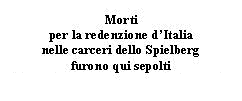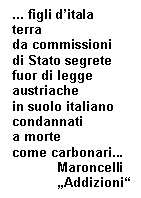Who are we?
Contacts
Collaboration
Site Map
Brno-spilberk <
Inscriptions of the Czech Republic <
Inscriptions <
Areas of Interest <
Welcome
For the Italian victims of the fortress on the Spilberk (Spielberg) hill, near Brno (Brünn), two monuments were erected: on the one hand a memorial stone standing in the surrounding park, on the other hand a plaque set in the wall of the fortress, near the monuments of the other nationalities.
Italian Monument in the Wall of the Fortress
A plaque was set in the wall of the fortress for the Italian victims as well as for those of other nations.
Original Text (in Italian Language)

Translation
|
From these "dark holes" |
Comment
The historical background is the Italian resistance against the annexion of Northern Italy by Austria after the Napoleonic wars.
The “dark holes” seem to be a quotation of “Le mie prigioni” (My Prisons), by Count Silvio Pellico, who was incarcerated here for eight years as a “Carbonaro”, according to the name all Italian resistance fighters were usually given at that time.
Pellico had been introduced to the Carbonari by Pietro Maroncelli and like him had been arrested and sentenced to death in 1820. The death penalty being commuted to 15 years of severe imprisonment, he was transferred to the Spilberk (Spielberg) in 1822, after two years of prison in Venise. But he was finally pardoned and released in 1830.
Historical Context at the Time when the Plaque was Set in the Wall
Unfortunately is there no date on the plaque itself. We would really appreciate any hint (with source indication). Just click here! Thank you!
Italian Monument in the Park
You will meet this monument when going up to the fortress from the centre of the city or later on your way down.
Original Text of the Upmost Inscription (in Italian language)

[After this, there are five names with dates of death.]
Translation
|
Having died [Follow the five names with dates of death.] |
Original Text of the Second Upper Inscription (in Italian language)

Translation
|
... sons of Italic earth Maroncelli |
Comment
The title “Addizioni” refers to the Italian translation of the “Additional Notes” Maroncelli wrote for his French version of Pellico’s “Le mie prigioni” (My Prisons).
Original Text of the Upper Inscription on the Plinth (in Italian language)

Translation
|
Erected by the - Dante Alighieri - |
Original Text of the Lower Inscription on the Plinth (in Czech language)

Translation
|
Sons of Italy sentenced to death Maroncelli |
As you see here, there is no surprise in the Czech translation, but it replaced the mythical “Italic earth” by the modern concept of “Italy”.
Historical Context at the Time when the Monument was Erected
In 1925 ... [to be completed]
If you have got any useful information on this topic, please click here to send it to us. Thank you!
Bibliography
Publications in English are to be completed, but I would like to draw your attention to the following publications in German, which reflect different opinions developed in more recent times.
|
Author / Title |
Notes |
Info / Purchase |
|
Brockhaus encyclopaedia in 17 volumes edited in 1885 |
This encyclopaedia edited only 65 years after Pellico being
pardoned and only 14 years after the foundation of the German empire gives
Pellico a fairly long article (volume
12, page 784 sq.) which contains the following interesting statements: |
|
|
Baedecker guide "Tschechien Slowakei" |
This guide speaks of Silvio Pellico in the article "Brno - Brünn" (page 142) as an "Italian poet and leader of the Carbonari". Pietro Maroncelli is not even mentioned. |
ISBN 3-87504-539-4 |
For more literature in German, French, or Italian, just click on the corresponding language near the top of this page.
Hans-Rudolf Hower, 2003
|
Holidays in Brno (Brünn)? Excellent idea! But where to stay? |
|
Whether you are looking for a room, an apartment, a hotel, a guest house,
or any other accommodation, |
Frequently-asked questions - Webmaster
Last updated: April 3, 2016